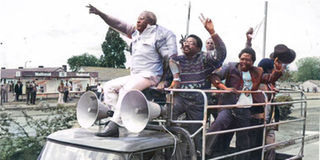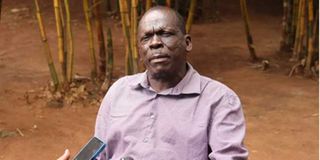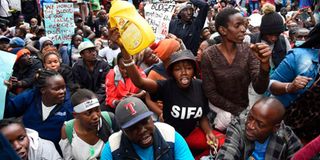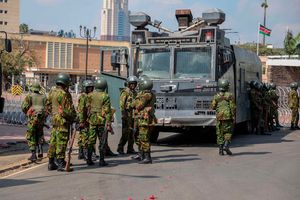
Opposition leaders heading to Kamukunji Grounds July 7, 1990.
When one day the history of Kenya is properly documented, it is likely to broadly map out three major moments of revolt that led to far-reaching changes and shaped how the country is governed: the fights for independence that intensified from the early 1950s until colonial rule ended in 1963, the 1990 Saba Saba revolt that forced the reintroduction of multipartyism and the Gen Z demonstrations which started in June last year and forced President William Ruto to cede some ground in his leadership.
Tucked in between are the two failed military coups — the 1971 plot against President Jomo Kenyatta led by the then military chief Major-Gen Joseph Ndolo and the violent 1982 attempt to overthrow President Daniel Moi spearheaded by the Kenya Air Force.
With tomorrow marking 35th Saba Saba anniversary, many agree that Project Kenya is still a work in progress and that it will take some more push and pull if the country is to really take off and the citizens enjoy the full freedoms they have long-yearned for.
All the incidents of uprising share the same motif of those in power resorting to raw brutal force to put down the ‘upstarts’ they felt was out to upset the apple cart: for the British colonialists it was a fight to save the last jewel of the crown while for President Moi and his ruling cabal, those agitating for multipartyism were out to disturb their ‘eating’. For President William Ruto and company, the Gen Zs are the pointed end of a bigger spear that aims at toppling the Kenya Kwanza administration.
With the Mau Mau freedoms fighters stepping up their offensive against white settlers and administration officials in Central Kenya and others fighting through trade unions and political parties, the British colonialists engaged in atrocities on a scale never seen anywhere else in the world.
Prof George Nyabuga of Aga Khan University of Graduate School of Media and Communications says that brutal force has been the favourite resort for unpopular regimes that have lorded it over Kenyans over the years.
Colonial government
“Those in power, from the colonial government to Kenyatta, Moi and now Ruto, use violence/brutal tactics – arrests, detentions (and now abductions and incarcerations), torture, disappearances, and killings – in attempts to suppress resistance and consolidate their power. They often believe that human suffering would serve as an example and thus make people lose the appetite for participation in the struggle for emancipation from dictatorship (and bad, brutal, irresponsible, unaccountable leadership),” he says.

Activist Wafula Buke at Zuri Poa Hotel Kanduyi Bungoma County on June 5, 2025.
Veteran opposition politician Wafula Buke, while agreeing with Prof Nyabuga, adds that despite the stiff resistance by those in power, the resilient Kenyan spirit has always triumphed even when the leaders choose to roll back the gains made.
“Jomo Kenyatta shot to the limelight against the background of impressive credentials. He had been associated with Mau Mau, a liberation movement that was respected in progressive circles across the globe. He had spent time in prison. He had all the necessary pedigree to be an earlier version of Nelson Mandela but when he became president he embarked on corruption and tribalism on a scale never seen anywhere before. Kenyatta was one of those African historical disasters,” Buke says.
Journalist-turned-politician Maneno Mwikwabe believes Mzee Kenyatta killed the Kenyan Dream. “Anybody who says otherwise is probably a tribal bigot and apologist of ethnic hegemony. The leadership that Kenyatta unleashed upon Kenya was large-scale looting, corruption, wanton greed and tribalism. That is the man who set Kenya on this destructive path of tribal entitlement through the oaths that he allowed in 1969 to protect himself against competition from both Oginga Odinga and Tom Joseph Mboya. Those were Kenyatta's friends in the struggle for self-rule,” said Mr Mwikwabe.
In between the politicians’ fight to make Kenya better, university students and a number of underground movements also played a major role over the years. Mr Buke was chairman of the powerful Students’ Organisation of Nairobi (Sonu) University, a position he was elected to in 1987.
Soon the regime of President Moi ensured that Mr Buke and some of his colleagues in Sonu were jailed on the trumped-up charges of spying for Muammar Gadaffi and Libya. He spent time in prison, where he learnt a lot about Marxism.
“We had good Marxists like Maina Kinyatti and Adhu Awiti. We used to have two hours of political education every day. On leaving prison we were given assignments on how to lead demonstrations. It was the kind of education you could never get in any university,” Mr Buke states.
For his part, Mr Mwikwabe set a record of sorts by being elected head of the Moi University Students Organisation (Muso) in his first year.
Saba Saba of 1990
“I was secretary-general of Muso in 1989/1990 and no one got there by being a softie. I was elected by a landslide in my first year despite my tribemates (the Kuria) being only four in the student population of 3,000! There was no consideration or tribe before Youth for Kanu 92’ tactics introduced District Students Associations funded by people like Hezekiah Oyugi (Internal Security Permanent Secretary) and the Moi system made tribalism one of the factors of student politics in our universities,” he says.
Both Mr Buke and Mr Mwikwabe agree that a strong and informed university population combined with committed politicians made Saba Saba of 1990 a success. Unfortunately, even after the repeal of Section 2 (a) which saw the reintroduction of multipartyism, several factors key among them politicians’ greed, ensured that the Kenyan Dream was killed.
“We have a sad situation in Kenya where those who never fought for anything end up getting the spoils of war. It happened after Saba Saba and it has continued to happen to date,” Mr Buke says.
Mr Mwikwabe says: “Tribalism, greed, and opportunism combined with the absence of clear ideological values killed the Kenyan Dream after Saba Saba. Some people believed they had the numbers and so presented themselves as ‘better’ leaders because their tribe had higher numbers. There was no ideology.”
He adds that even Jaramogi Oginga Odinga did not present himself as an ideological option but as the Luo leader.

Kenyans protest outside the Office of the President in Nairobi on July 7, 2022, over the high cost of living.
Mr Buke believes that former Prime Minister Raila Odinga’s move to work with President Ruto dealt a big blow to the Gen Z movement of last year. Had he left Dr Ruto to be at the place where the Gen Z demos had pushed him, Kenya would have made great strides towards just governance, he avers.
Mr Mwikwabe says: “Now that Gen Zs know their enemies, they will react better and more strategically. You can be sure they will not follow the tribal order to vote for ‘one of our own’ because none of the political leadership is their own.”
He adds: “If I am to draw from my win at Moi University, I was very articulate on what I thought we could achieve as students, ignorant of the fact that Universities are governed by statutes. But I also won because my year mates were the majority. The next year presented a new majority, which I knew was difficult to beat based on their numbers. ‘One of our own’ made sense as mobilisation of groups based on their common interests.”






